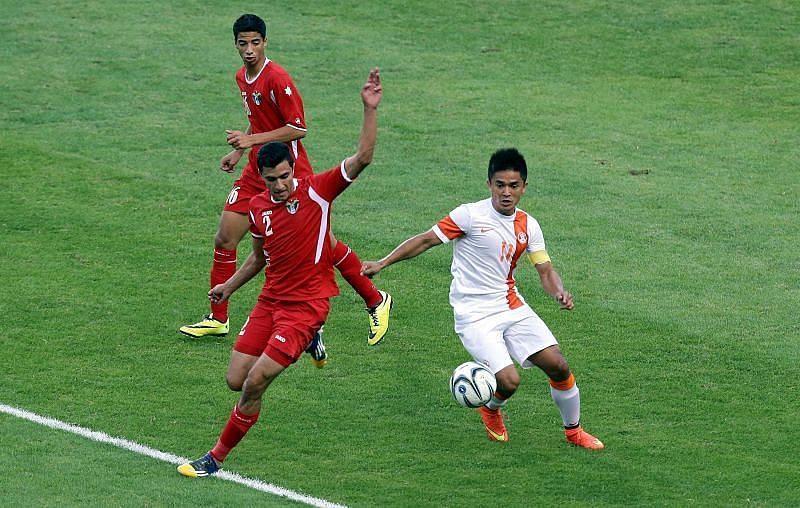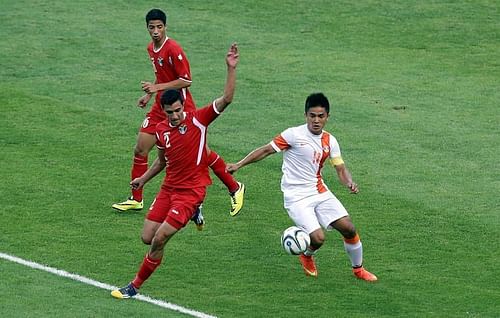
India's tryst with football before the advent of ISL

1975 - Calcutta
The northern neighborhood of Sinthee is densely populated, characterized by closely built brick houses. One fine morning, my grandfather makes his way to the terrace, visibly disturbed, accompanied by my then 13-year-old father.
The terrace, back in those days, was often a hub for early morning debates. You see, they didn’t really have telephones back then, but in what was a very closely packed town, the terrace allowed them to look at and communicate with fellow peers standing on another. It wasn’t the most effective mode of communication, however, with thinly veiled rants - ranging from politics to sports to even petty household gossip - often being audible to pretty much every house in between.
But today, there was no debate.
On the roof across the street, my father saw a familiar face. He recollects:
"He lifted his left hand and then gestured triumphantly with his five fingers facing us."
My old man had nothing to say. He simply turned his back on him, and sank into his wooden chair. Deep inside, even as a kid, I knew he was hurt and embarrassed.
The familiar face was our old neighbor. For a long time, our families had shared an amicable relationship. A college student, during the partition of India in 1947, he, like many others, left his hometown of Faridpur (now in Bangladesh) and crossed borders to settle down in Calcutta. Understandably, with his roots in eastern Bengal - a 'Bangal' as they are called in colloquial terms - he had pledged his loyalties to the football club of East Bengal.
My grandfather, on the other hand, was a staunch Mohun Bagan fan - the fierce city rivals of East Bengal - historically supported by the nativist population of Calcutta, also called the 'Ghotis'.
Hours earlier, the Red and Gold brigade of East Bengal had decimated their illustrious neighbors 5-0 in the IFA Shield final. It was a humiliating defeat - one that helped East Bengal reach a unique record of four consecutive Shield triumphs.
As this scene unfolded in my hometown, somewhere in the middle of the Ganges, star Bagan players Prasun Banerjee and Subrata Bhattacharya were being rescued by a former Indian captain Sailen Manna. The duo had barely escaped the wrath of hundreds of angry supporters surrounding the club tent and spent the night in a river-boat.
Incidentally, both Prasun and Subrata would go on to become part of India’s finest group of footballers.
It was indeed an embarrassing defeat - for this was the very tournament in which Mohun Bagan had established themselves as a symbol of India’s freedom struggle. The 1911 edition of the IFA Shield saw 11 barefooted men from Bagan defeat a highly fancied East Yorkshire Regiment side in the final; ushering in nationwide joy as the underdogs celebrated their triumph over their colonial rulers.
Within seconds of the final whistle, the entire city was filled with the battle-cries of “Bande Mataram” and “Jai Hind”, as the English made a hasty exit in front of an 80,000 strong hostile crowd.
It was a pivotal victory that contributed largely to building Indian self-confidence during the on-going struggle for independence - one which exposed the myth of British invincibility. It was not just a triumph on the football field but a triumph for India’s awakening nationalism.
Football, merely a leisure sport up until now, had suddenly shown it could have massive implications on the socio-political dimensions of India, transcending the boundaries of state and religion. As the Englishman daily had then famously cited - Mohun Bagan succeeded in what the “Congress and the Swadeshiwallas” had failed to do so far.
Four years on, however, it was a bitter pill to swallow - the club’s pride completely demolished at the hands of their bitter rivals. In a rather unfortunate incident, a Mohun Bagan supporter Umakanto Palodhi gave up his life; unable to bear the harsh reality. In his suicide note, he wrote:
“In my next birth, I will take revenge by becoming a Mohun Bagan footballer.”
For East Bengal fans, it was their moment of glory. The partition had brought upon uncertain times on the large contingent of refugees who had to leave their homeland and travel west to Indian territories. In those periods of trying times, they had embraced the game of football; they had embraced East Bengal football club - a club symbolizing the past they left behind. And while they did enjoy considerable success over the years, this was finally the jewel in the crown. Often subject to unjust taunts of being ‘un-Indian’ and ‘immigrants’, the other half of Calcutta had finally found their bragging rights.
As the world remained in oblivion to India’s existence in the world footballing map, on that fateful day of October 1st 1975, contrasting emotions of celebration, triumph, sorrow and embarrassment pervaded the nation’s two partisan set of football fans. Football, once again, had its drastic effect on the country, like it had six decades ago.
The rivalry between the two clubs remains to this day - an encounter between them once drew an estimated attendance of 100,000 at the historic Salt Lake Stadium.
The rise of northeast
About 350 miles to the east of the plain terrain of Calcutta, the calmness and esthetic beauty of the hills of northeast India can be a bewitching disguise for the pain that lies beneath. Connected to East India via a narrow corridor squeezed between Bhutan and Bangladesh, the “seven sister” states of India remain vastly neglected, marred by lack of development, insurgency and inter-ethnic violence.
Yet when Tomba Singh’s golden goal handed the small state of Manipur victory over traditional heavyweight Kerala in the final of the Santosh Trophy (India’s elite inter-state cup competition) in 2002, the entire northeast unified in celebration. After years of being under the shadows of misfortune, they finally had the rights to be called “Kings of India” - a maiden champion from the region had emerged. In the midst of darkness, football became a source of hope and self-esteem for the people of northeast.
A little over a decade later, neighbor Mizoram would repeat the feat. Success would go on to bring about a footballing revolution in the north-east, producing footballers originating from the most primitive of infrastructures but matching or outshining footballers from elsewhere in the national set-up. At a time when they had very little to hold on to, football came about as their genesis of pride and inspiration.
The Goan game
While the introduction of football in the country could largely be credited to India’s former colonial rulers, the scenario in the far west along the sultry beaches of Goa was somewhat different. In 1498, the Portuguese contingent led by Vasco Da Gama reached the western shores of India, linking Europe and Asia for the first time by an ocean route and with them introduced the Catholic Church to India. However, by the end of the nineteenth century, after years of being under Portuguese rule, the church was no longer seen as a colonial institution in Goa, but was rather something that had - through generations after generations - become an inextricable part of the Goan identity and was run by the locals themselves.
Although not forced upon them by the colonial authorities, the church, which was by now very much indigenized, started promoting and encouraging the game of football, realizing it could strengthen unity and shore up the existing social structures. The result of the games hardly mattered; football was a medium of consolidating their faith and culture.
By 1950s, the game was well and truly flourishing in Goa.
However, it was also the time when India had already freed herself from the British Empire and the talks of ceding Goa to the newly formed republic were finally gathering momentum. The Portuguese, led by Prime Minister Oliveira Salazar, refused to give in to the pressure and were adamant that Goa was essentially a Portuguese province and had developed as a European society over the last four centuries.
To assert such a claim, however, Portugal had to form a cultural association with Goa; to make them realize that they were "one of them," rather than a distant colony.
And well, it did not take long to identify the medium to do so.
A well-structured Goa based football league was soon formed. To further highlight Goa’s importance in the Portuguese empire, notable visits by major football teams from the empire, including one by a high profile Benfica side, were arranged.
The Port Trust Club of Karachi was strategically invited from Pakistan in 1959, symbolizing unanimity with a footballing country which hasn’t had the best of relations with India. Football, being a game already loved and adored by large sections of the population, these matches attracted massive crowds — a perfect setup for the Portuguese administration to showcase their effectiveness and concern towards their colony’s interests.
These last ditch attempts to keep Goa unified with the Portuguese empire would eventually fail, as India annexed the region following a military operation in 1961. However, football’s presence in key social, political and cultural avenues of Goa could hardly be ignored. The enthusiasm for the game was channelized to influence pivotal aspects on a much broader scale. As in other parts of the country, football in Goa did not remain merely a game!
ISL ushered in a new era in Indian football
India’s passion for football has often remained buried under the nation’s dubious record on the international stage. The advent of the cash-rich Indian Super League (ISL) in 2014 has finally allowed the world to take notice, but has brought with it the somewhat misguided notion that the game is only now picking up and having an impact on the subcontinent.
Well, although this notion is true to an extent — backed up by massive stadium attendances, record numbers in the form of television viewership as well as the influx of large amount of money from private organizations - delving a little deeper into the country’s history would reveal that football’s impact on the Indian society and culture has been far more significant and stretches further back than the birth of the ISL.
In 2007, FIFA president Sepp Blatter described India as a “sleeping giant” of world football. But perhaps it was the world that had been sleeping - incognizant of the adventures of Indian football!